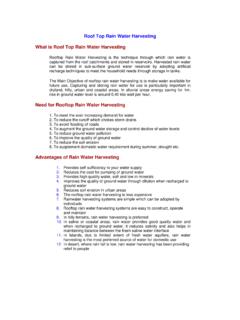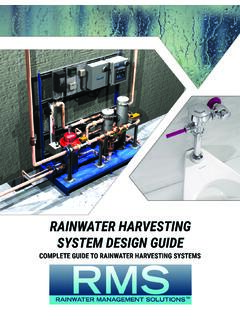Transcription of Crop production manual
1 Ii Crop production manual A guide to fruit and vegetable production in the Federated States of Micronesia iii iv Crop production manual A guide to fruit and vegetable production in the Federated States of Micronesia Compiled by: Sayed Mohammad Naim Khalid This manual was produced under TCP/MIC/3601, Strengthening the capacity of Farmers Associations to increase production and marketing of root crops, fruits and vegetables in FSM project. FAO Subregional Office for the Pacific Food and Agriculture Organization of the United Nations Apia, 2020 v Required citation: FAO. 2020. Crop production manual . Appia. The designations employed and the presentation of material in this information product do not imply the expression of any opinion whatsoever on the part of the Food and Agriculture Organization of the United Nations (FAO) concerning the legal or development status of any country, territory, city or area or of its authorities, or concerning the delimitation of its frontiers or boundaries.
2 The mention of specific companies or products of manufacturers, whether or not these have been patented, does not imply that these have been endorsed or recommended by FAO in preference to others of a similar nature that are not mentioned. The views expressed in this information product are those of the author(s) and do not necessarily reflect the views or policies of FAO. ISBN 978-92-5-132128-7 FAO, 2020 Some rights reserved. This work is made available under the Creative Commons Attribution-NonCommercial-ShareAlike IGO licence (CC BY-NC-SA IGO; ). Under the terms of this licence, this work may be copied, redistributed and adapted for non-commercial purposes, provided that the work is appropriately cited. In any use of this work, there should be no suggestion that FAO endorses any specific organization, products or services. The use of the FAO logo is not permitted.
3 If the work is adapted, then it must be licensed under the same or equivalent Creative Commons licence. If a translation of this work is created, it must include the following disclaimer along with the required citation: This translation was not created by the Food and Agriculture Organization of the United Nations (FAO). FAO is not responsible for the content or accuracy of this translation. The original [Language] edition shall be the authoritative edition. Disputes arising under the licence that cannot be settled amicably will be resolved by mediation and arbitration as described in Article 8 of the licence except as otherwise provided herein. The applicable mediation rules will be the mediation rules of the World Intellectual Property Organization and any arbitration will be conducted in accordance with the Arbitration Rules of the United Nations Commission on International Trade Law (UNCITRAL).
4 Third-party materials. Users wishing to reuse material from this work that is attributed to a third party, such as tables, figures or images, are responsible for determining whether permission is needed for that reuse and for obtaining permission from the copyright holder. The risk of claims resulting from infringement of any third-party-owned component in the work rests solely with the user. Sales, rights and licensing. FAO information products are available on the FAO website ( ) and can be purchased through Requests for commercial use should be submitted via: Queries regarding rights and licensing should be submitted to: Cover photographs: FAO/ K. Hadfield iv Contents Preface .. viii ix Farming basics .. 1 Introduction .. 3 Why start your own farm? .. 3 Picking a good spot for your garden .. 3 Choosing what crops to plant .. 4 Finding seeds/seedlings.
5 5 Planning your farm .. 5 Layout .. 5 Raised beds .. 5 Traditional rows .. 6 Square foot gardening .. 6 Mulching .. 6 When to plant .. 6 Improving the soil .. 7 Testing the soil .. 7 Clearing weeds .. 7 Compost .. 8 Manure .. 8 Planting the crops .. 8 Succession planting .. 9 v Crop rotation .. 9 Maintaining the garden .. 10 Watering .. 10 Weed control .. 11 Pest control .. 11 Fertilizer .. 11 Harvesting the crops .. 12 Organic pest control .. 14 Root crops 15 Sweet potato (Ipomoea batatas) .. 17 Swamp taro (Cyrtosperma merkusii) .. 18 Cassava (Manihot esculenta) .. 19 Taro (Colocasia esculenta) .. 20 Arrowleaf elephant (Xanthosoma .. 21 saggitifolium) .. 21 Ginger (Zingiber officinale) .. 22 Turmeric (Curcuma longa) .. 23 Yam (Dioscorea alata) .. 24 Vegetable production .. 25 Capsicum (Capsicum grossum) .. 27 Chillies (Capsicum annuum) .. 29 Chinese cabbage (Brassica chinensis) .. 30 Corriander (Coriandrum sativum).
6 31 Cucumber (Cucumis sativus) .. 32 Eggplant (Solanum melongena) .. 33 vi French bean (Phaseolus vulgaris) .. 34 Lettuce (Lactusa sativa) .. 35 Long bean (Vigna sesquipedalis) .. 36 Okra (Abelmoschus esculentus) .. 37 Pumpkin (Cucurbita maxima) .. 38 Radish (Raphanus sativus) .. 39 Spring onion (Allium cepa) .. 40 Zucchini (Cucurbita pepo) .. 42 Fruit production .. 43 Acid lime (Citrus aurantifolia) .. 45 Sweet orange (Citrus sinensis) .. 46 Mandarin orange (Citrus reticulate) .. 47 Sapota (Manilkhara achras) .. 48 Avocado (Persia americana) .. 49 Passionfruit (Passiflora edulis) .. 50 Pineapple (Ananas comosus) .. 51 Watermelon (Citullus lanatus) .. 52 Banana (Musa sapientum) .. 53 Coconut (Cocos nucifera) .. 55 Kura (Noni) (Morinda citrifolia) .. 56 Mango (Mangifera indica) .. 57 Papaya (Carica papaya) .. 58 Soursop (Annona muricata) .. 59 Vanilla (Vanilla fragrans) .. 60 Tamarind (Tamarindus indica L).
7 61 vii Dragon fruit (Hylocereus undatus) .. 62 Star apple (C. cainito L.) .. 63 Mangosteen (Garcinia mangostana) .. 64 Lanzones (Lansium domesticum C) .. 65 Rambutan (Nephelium lappaceum Linn.).. 66 Barbados cherry (Malpighia punicifolia L.) .. 67 Annex 1: A guide to backyard composting .. 69 Annex 2: Natural and homemade pesticides .. 71 Annex 3: Synthetic fertilizers .. 75 References and further reading .. 80 viii Preface This manual is intended to be a guide to the agriculture extension personnel, horticultural producers as well as agricultural institutions in their endeavor to improve productivity in the horticultural sub-sector. This manual will raise awareness and provide decision support information about opportunities at farm and how to do basic farming for subsistence and market and ultimately increase the income of farmers and improve their livelihoods. Pohnpei and Yap States currently produce limited amount of food locally and export is also limited.
8 The imports of substantial quantities of vegetables, fruits and root crops is amounting to millions of dollars annually. This is partly owing to the fact that the necessary information on crop production locally is not readily available to assist producers in their production . This manual is designed to provide guidelines on seedling production and management, plant spacing, cropping program, soil fertility and crop protection. It is hoped that this manual will contribute modestly to the goal of improving vegetable production in the country. ix Acknowledgements The following individual contributed to conceptualization, writing, reviewing, editing, and improving technical accuracy of this manual . Their valuable contributions are hereby gratefully acknowledged: Mr. Adelino Lorens - Chief of Agriculture Pohnpei, FSM Ms. Marlyter Silbanuz National Project Coordinator, FSM Mr. Tamdad Sulag Chief of Agriculture Yap, FSM Dr.
9 Nacanieli (Nat) Tuivavalagi Agronomy Researcher, College ofMicronesia, FSM Mr. Konrad Englberger Volunteer Plant Protection Expert, FSM Mr. Jackson Phillip Program Coordinator, College of MicronesiaFSM Mr. Sawdey, Sharon Resource Conservationist, NRCS/USDA - FSM Dr. Leon Numaco Horticulture Consultant, FAO Mr. Gumercindo Tumbali Farm Management & MarketingConsultant, FAO Mr. Kadalino Lorens Agriculturist, Division of Agriculture,Department of R&D Pohnpei State, FSM Mr. Santos, Gibson Soil Conservation Technician, NRCS/USDA, FSM Mr. Nicholson Solomon Director, Department of Resources &Development, Pohnpei, FSM1 Farming basics 2 3 Farming basics Introduction With so much emphasis today on eating natural, organic foods not to mention the rising costs associated with buying them, many people are considering growing their own vegetables in a home garden. It s very easy to grow your own vegetables, and at harvest time, vegetable gardening is a very rewarding pastime.
10 All your garden really needs is sunshine (6 8 hours of sun each day, in the summer), some soil, fertilizer, and a little attention to watering, weeding and pest management. As a gardening beginner, your first vegetable garden will require the largest amount of work, but don t let that dissuade you the work you put in up front won t have to be repeated next year, and the rewards speak for themselves. Why start your own farm? Across the world, many people are having little farms. In FSM most people have access to land and the climate is suitable for crop production . And for the cost of seeds, tools, and water , they re enjoying food that s as fresh and local as it can possibly be, all while spending less time shopping for groceries and more time at home, connecting with their family and friends. As you can see, there are many great reasons to start your own farm. Apart from allowing you to grow your own food, conserving energy and saving money, own farm will also help to control runoff from rainfall and guard against flooding.













